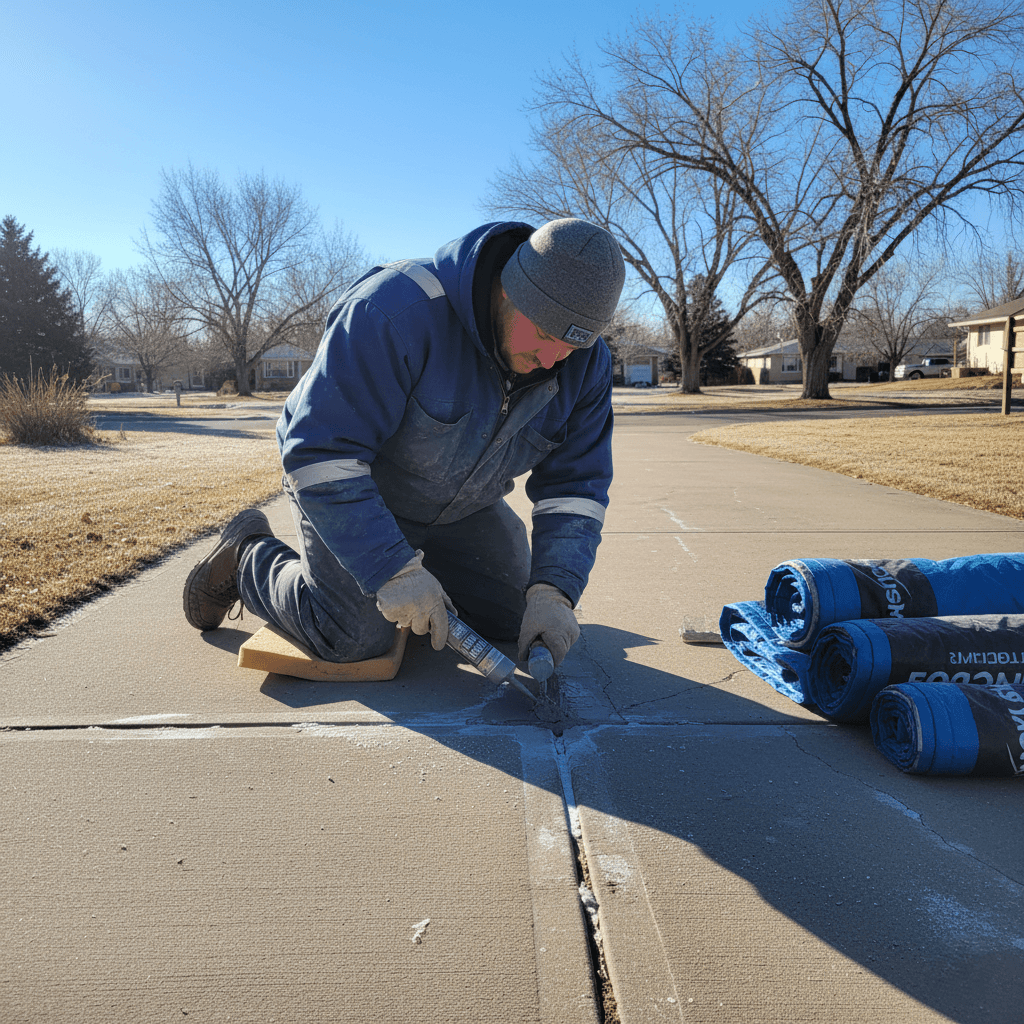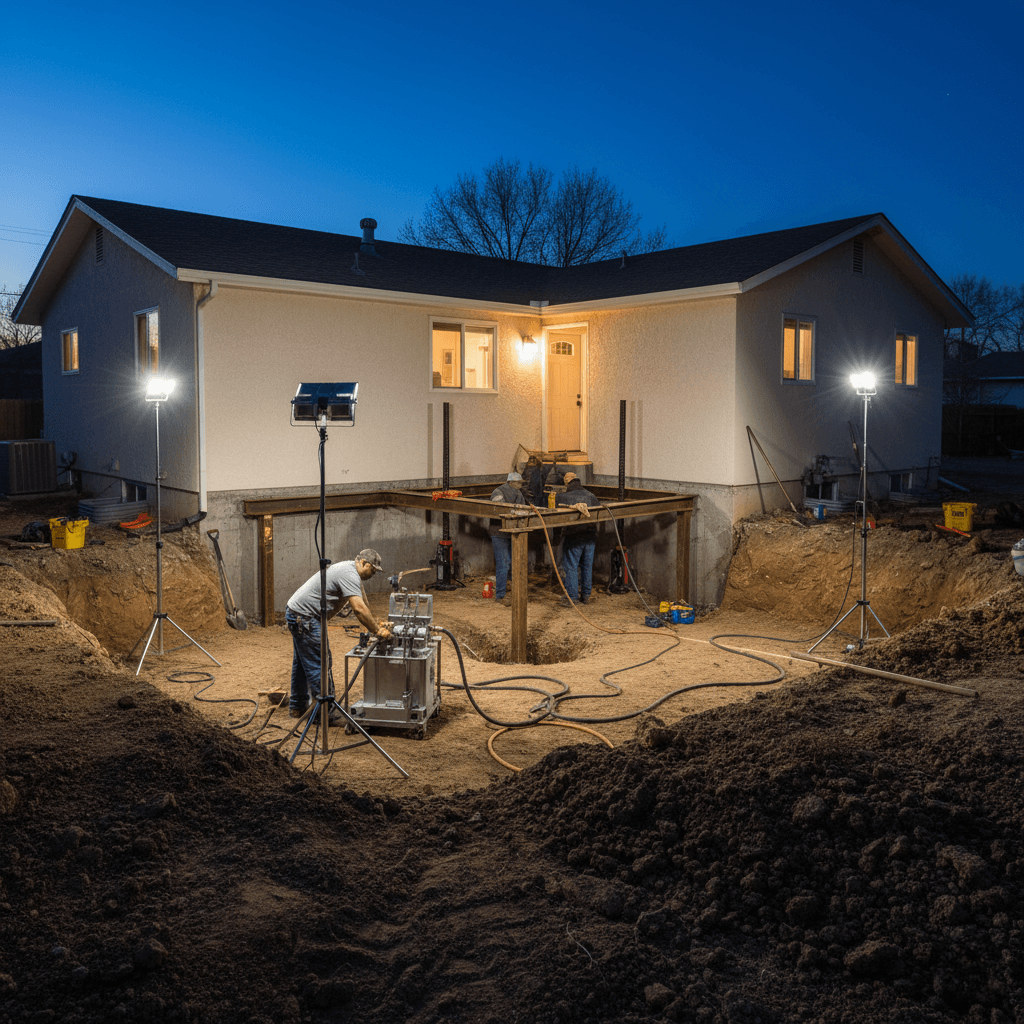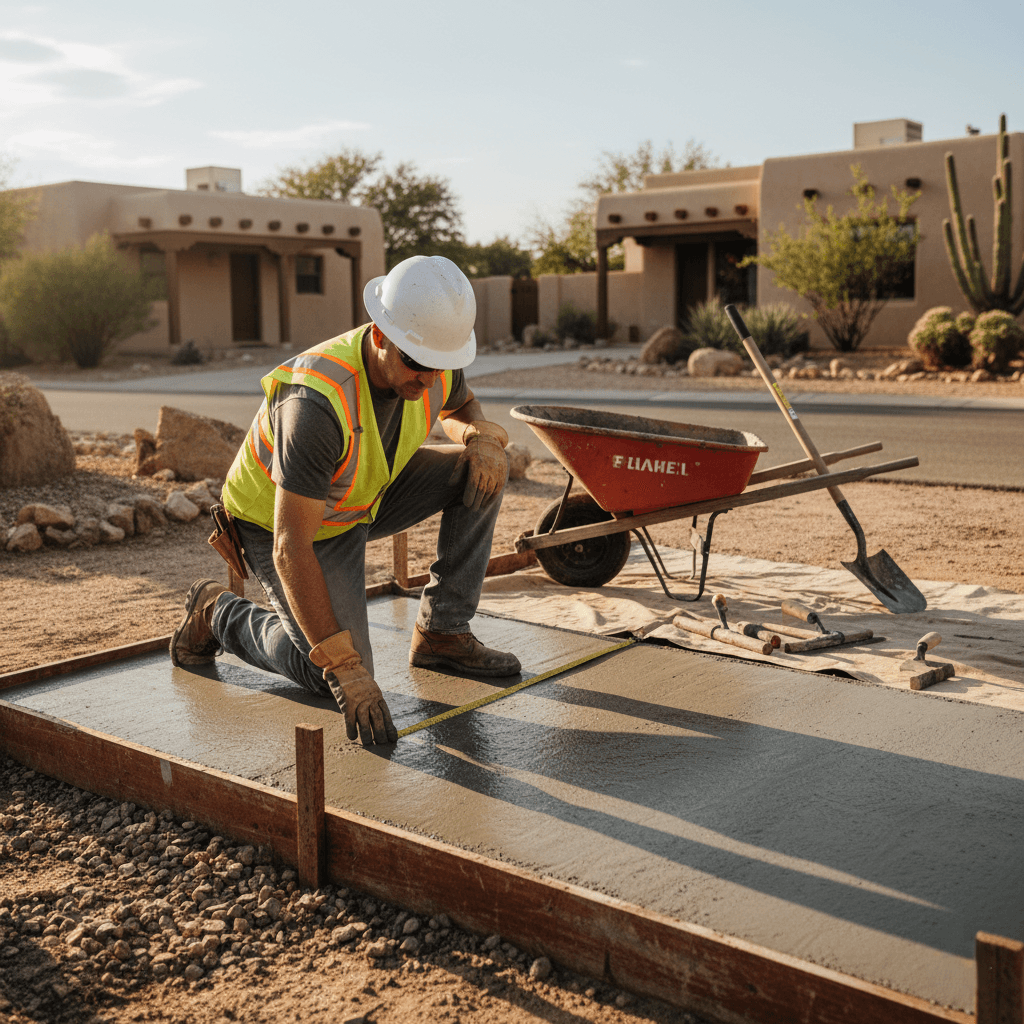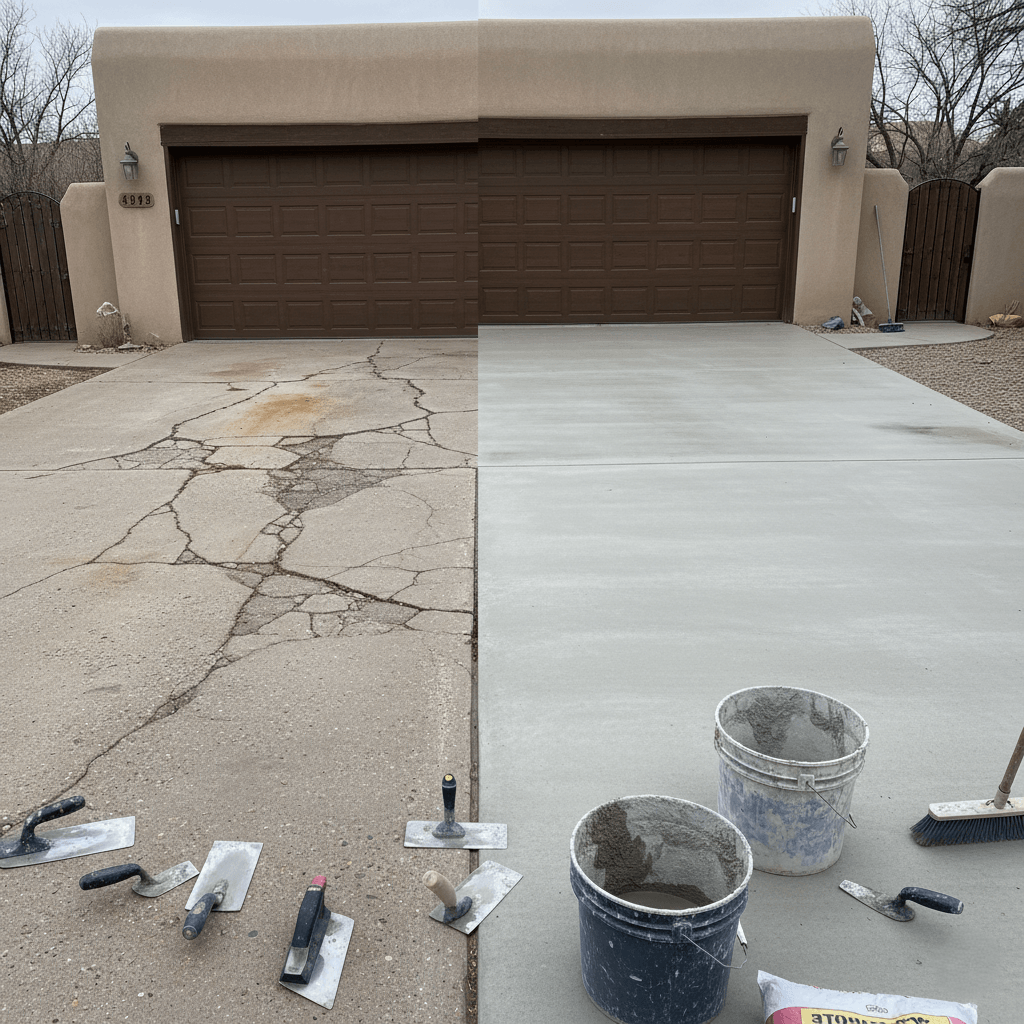
Cold Weather Concrete Repair Tips for Pueblo
Concrete Repair Pueblo
Winter presents unique challenges for concrete repair in Pueblo, where temperatures regularly drop below freezing and intense sun creates dramatic daily temperature swings. Understanding how cold weather affects concrete repair processes helps homeowners and contractors achieve successful results despite harsh conditions. Pueblo’s semi-arid climate combines freezing nights with sunny days, creating opportunities for repairs when properly timed and executed. The key lies in recognizing when conditions permit repairs and implementing appropriate cold-weather techniques. These practical tips enable effective concrete repair throughout Pueblo’s winter months while ensuring long-lasting, quality results.

Understanding Cold Weather Concrete Challenges
The American Concrete Institute defines cold weather as periods when average daily temperatures fall below 40 degrees Fahrenheit for more than three consecutive days. Pueblo regularly experiences these conditions from November through March. Cold temperatures slow the chemical reaction that allows concrete repair materials to cure and gain strength. Below 40 degrees, the curing process dramatically slows, and below 32 degrees, it essentially stops.
Freezing before repair materials achieve minimum strength causes permanent damage. The water within fresh concrete expands when freezing, disrupting the internal structure and compromising bond strength. Materials must reach approximately 500 PSI before freezing to avoid this damage. Properties throughout neighborhoods like Aberdeen and Belmont face these challenges during Pueblo winters. Understanding these fundamental issues guides all cold-weather repair decisions.
Optimal Timing for Winter Repairs
Taking Advantage of Sunny Days
Pueblo’s abundant winter sunshine creates favorable repair windows despite cold air temperatures. Direct sunlight can raise concrete surface temperatures 15 to 25 degrees above ambient air temperature. A day with 30-degree air temperature might see concrete surfaces reach 45 to 55 degrees in full sun. These conditions allow successful repairs when properly timed.
Plan repairs to begin mid-morning after surfaces warm from the sun’s exposure. Complete work by early afternoon, allowing several hours of warmth for initial curing before evening temperatures drop. Properties with southern exposure throughout Pueblo benefit from maximum sun exposure. Areas like University Park and Eagleridge with open exposure receive optimal winter sunlight. We schedule winter repairs strategically to maximize these natural advantages.
Monitoring Weather Forecasts
Check extended forecasts before scheduling repairs, looking for multi-day periods with temperatures above freezing. Repair materials need 24 to 48 hours above 40 degrees for adequate initial strength development. A sunny day followed by freezing overnight temperatures creates problems for fresh repairs. Avoid repairs when forecasts predict temperatures below 40 degrees within 48 hours of application.
Pay attention to overnight low temperatures and daytime highs when planning projects. Properties in Pueblo benefit from our region’s typical pattern of cold nights followed by warming days. However, arctic air masses occasionally bring sustained freezing temperatures that require postponing repairs. We monitor multiple forecast sources to make informed timing decisions for winter repair projects.
Surface Preparation in Cold Weather
Clean surfaces thoroughly before applying repair materials, removing all ice, snow, and frost. These contaminants prevent proper bonding and introduce excess moisture that compromises repairs. Use brooms or leaf blowers rather than water for cleaning when temperatures hover near freezing. Water cleaning in cold weather creates additional ice problems.
Allow frozen concrete to thaw completely before attempting repairs. Heating blankets or propane heaters can accelerate thawing when necessary. The substrate temperature should reach at least 40 degrees before applying repair materials. Use an infrared thermometer to verify surface temperatures accurately. Properties throughout Pueblo requiring emergency repairs sometimes need active heating to prepare surfaces properly during winter.
Material Selection for Cold Conditions
Cold-Weather Repair Products
Specialized repair materials formulated for cold weather perform better than standard products during Pueblo winters. These products contain accelerators that speed curing even at lower temperatures. Cold-weather patching compounds remain workable longer in cool conditions while still achieving adequate strength quickly. The investment in proper materials prevents repair failures that cost far more to redo.
Read product labels carefully to verify temperature ranges for application. Some materials work down to 25 degrees, while others require 40 degrees minimum. Store repair materials in heated spaces before use to maintain workability. Cold materials prove difficult to mix and apply properly. We stock appropriate cold-weather products throughout winter to ensure repairs meet quality standards.
Avoiding Standard Summer Products
Standard concrete repair materials designed for moderate temperatures fail in cold conditions. The curing process stalls at low temperatures, preventing proper strength development. Materials may appear to set but lack the necessary bond strength and durability. Using inappropriate products wastes time and money while failing to solve the original problem.
Properties throughout Pueblo sometimes experience failed repairs from well-intentioned but inappropriate product choices. The temptation to use available materials rather than obtaining proper cold-weather products leads to disappointment. Postponing repairs until you have the correct materials produces better results than rushing with inadequate products. We maintain appropriate material inventory specifically for winter repair needs.
Crack Repair Techniques
Small crack repairs proceed more successfully in cold weather than large structural repairs. The limited material volume cures faster and requires less heat retention. Clean cracks thoroughly, removing all loose material and debris. Dry cracks completely before filling, as moisture freezing within the repair material causes failure.
Use flexible crack sealants specifically rated for cold-weather application. These products remain pliable at low temperatures and bond effectively despite thermal contraction. Rigid fillers often fail in winter because thermal movement stresses the repair. Properties in neighborhoods like Mesa Junction and Belmont benefit from flexible repairs that accommodate Pueblo’s temperature extremes. Apply sealants in thin layers rather than attempting to fill deep cracks in a single application.
Protecting Fresh Repairs
Insulation Methods
Cover fresh repairs with insulating blankets to retain heat during the critical curing period. The concrete’s natural heat of hydration combines with retained solar warmth to maintain adequate curing temperatures. Straw bales, foam insulation boards, or commercial curing blankets provide effective protection. Secure covers to prevent wind from displacing them overnight.
Leave insulation in place for 48 to 72 hours minimum, depending on ambient temperatures. Gradual cooling prevents thermal shock that can crack repairs. Remove protection during warm afternoon periods, then replace it before evening temperatures drop. Properties throughout Pueblo requiring winter repairs benefit from this simple but effective protection method. The modest cost of insulation materials prevents repair failures worth hundreds or thousands of dollars.
Heated Enclosures
Large repairs in extremely cold conditions may require temporary heated enclosures. Plastic sheeting creates a tent around the repair area while propane heaters maintain above-freezing temperatures. This approach allows repairs during sustained cold periods that would otherwise prevent work. The added expense proves worthwhile when repairs cannot wait for better weather.
Monitor temperatures inside enclosures carefully to prevent overheating that causes rapid drying. Maintain temperatures between 50 and 70 degrees for optimal curing. Adequate ventilation prevents carbon monoxide accumulation from propane heaters. We use heated enclosures for critical repairs that must proceed during unfavorable winter conditions throughout Pueblo.
Avoiding Deicing Chemicals
Never apply deicing salts to fresh concrete repairs or newly installed concrete surfaces. The chemicals penetrate the surface and disrupt the curing process while causing internal damage. Salt accelerates freeze-thaw deterioration by allowing water to penetrate deeper into concrete. The damage from deicing chemicals often exceeds the problems the repair addresses initially.
Use sand, kitty litter, or non-chemical traction materials on concrete surfaces during winter. These alternatives provide safety without damaging concrete. Even mature concrete suffers from repeated salt exposure, making alternatives preferable year-round. Properties throughout Pueblo extend concrete life significantly by avoiding deicing salts. We educate homeowners about the long-term consequences of salt use on concrete surfaces.
When to Postpone Repairs
Some repairs must wait for warmer weather despite the urgency temptation. Large structural repairs, extensive resurfacing projects, or new concrete installations require sustained favorable conditions. Attempting these projects in cold weather risks significant failures that necessitate complete replacement. The cost of waiting proves far less than the expense of failed repairs.
Forecast periods with sustained temperatures below 40 degrees indicate poor conditions for any concrete repair. Emergency temporary repairs might prevent immediate damage while awaiting better weather for permanent solutions. Properties experiencing serious problems during deep winter sometimes need temporary protective measures. We provide honest assessments about which repairs can proceed and which should wait for spring.
Emergency Temporary Repairs
When permanent repairs prove impossible due to weather, temporary measures prevent damage from worsening. Cover cracks with waterproof tape or plastic sheeting to exclude moisture. Redirect water away from damaged areas using temporary barriers or drainage adjustments. These stopgap measures protect concrete until proper repairs become feasible.
Apply temporary patches using cold-weather products, understanding they may require replacement in spring. The goal becomes preventing water infiltration and freeze-thaw damage rather than achieving permanent repairs. Properties throughout Pueblo sometimes need these interim solutions during harsh winter periods. We implement appropriate temporary measures while planning comprehensive repairs for favorable conditions.
Leveling and Lifting Considerations
Concrete leveling using mudjacking or foam injection can proceed during Pueblo winters with proper precautions. Ground temperatures matter more than air temperatures for these repairs. The substrate must remain above freezing for materials to cure properly. Sunny days warm the ground even when air temperatures stay cold.
Foam leveling works better than mudjacking in cold weather because it cures through chemical reaction rather than simply hardening. The reaction generates heat that aids curing despite cold conditions. However, extremely cold ground can absorb heat too quickly, preventing proper foam expansion. We evaluate ground conditions carefully before attempting leveling repairs during winter. Properties in Skyview, West Park, and throughout Pueblo receive leveling services year-round when conditions permit.
Interior Repairs
Basement and garage floor repairs proceed normally during winter since interior temperatures remain moderate. These protected environments eliminate cold-weather concerns entirely. Focus winter repair efforts on interior projects when exterior conditions prove unfavorable. Interior repairs require the same quality materials and techniques as exterior work, but without weather complications.
Schedule exterior repairs for spring while addressing interior concrete problems during winter. This strategy maximizes productive repair time throughout the year. Properties throughout Pueblo benefit from year-round repair services by prioritizing interior work during challenging winter weather. We help homeowners develop comprehensive repair plans that account for seasonal limitations.
Professional Assessment Benefits
Determining whether winter conditions permit repairs requires experience and judgment. Professional assessment evaluates weather forecasts, material requirements, and project scope to recommend optimal timing. Our familiarity with Pueblo’s specific climate patterns informs these decisions. What works in other regions may fail here due to our unique conditions.
We provide honest guidance about repair feasibility during winter consultations. Recommending delays when appropriate protects your investment and our reputation. Properties throughout Pueblo receive reliable advice based on decades of local experience. The assessment cost proves minimal compared to the expense of failed repairs from poor timing or technique.
Planning for Spring
Use the winter months to plan major repairs for spring execution. Obtain estimates, schedule concrete contractors, and order materials while the weather prevents work. This preparation ensures prompt repair completion when favorable conditions arrive. Spring represents peak season for concrete repair, making early scheduling advantageous.
Identify all necessary repairs during winter, prioritizing them by urgency and feasibility. Small repairs that can proceed during favorable winter days are separate from large projects requiring sustained warm weather. Properties throughout Pueblo benefit from strategic repair planning that maximizes efficiency. We help develop comprehensive repair schedules that work within seasonal constraints.
Maintenance to Prevent Winter Damage
Proactive maintenance before winter reduces the need for cold-weather emergency repairs. Seal existing cracks in the fall to prevent water infiltration during freeze-thaw cycles. Apply quality concrete sealer to protect surfaces from moisture and salt damage. Clean drainage systems to prevent water accumulation near concrete structures.
Remove snow promptly from concrete surfaces to minimize moisture exposure. Use plastic shovels rather than metal to avoid surface damage during snow removal. Maintain proper drainage away from foundations and slabs throughout winter. Properties implementing these preventive measures experience fewer problems requiring urgent winter repairs. We recommend comprehensive fall preparation to minimize winter concrete damage.
Making Informed Winter Repair Decisions
Successful cold-weather concrete repair requires understanding Pueblo’s unique climate, using appropriate materials and techniques, and timing work strategically. Small repairs often proceed successfully during favorable winter days, while major projects typically wait for spring. Professional guidance helps distinguish between repairs that can proceed safely and those requiring postponement.
Protecting fresh repairs, avoiding deicing salts, and implementing temporary measures when necessary prevent winter damage from worsening. At Pueblo Concrete Services, we provide expert concrete repair services year-round, utilizing proven cold-weather techniques and materials when conditions permit, while honestly advising when postponing repairs serves homeowners better, ensuring quality results that protect your investment regardless of season.



